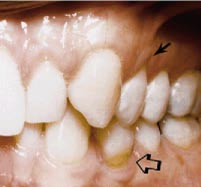Adult patients with cervical recession, erosion, or abrasion often have exposed dentin (Fig. 1), which is especially sensitive to the chemicals used to etch enamel for orthodontic bonding. I use a calcium hydroxide paste (Dycal) to protect the enamel during what I am careful to call "enamel conditioning" (patients don't like to hear that their teeth are being etched with acid).
Prepare the paste according to the manufacturer's instructions, and apply it with a small toothpick to any exposed dentin. Apply phosphoric acid gel as usual for 20 seconds before sealing the enamel surface and bonding the bracket (Fig. 2). The paste is easily removed after bonding.
In a case of extreme dentin notching, the dentist will often restore the area with a glass ionomer restorative cement. This surface can be conditioned and bonded just as with enamel. Such an area should be noted so that special care can be taken during debonding and polishing.
If root sensitivity is a problem, direct application of a dentin-sclerosing agent (Protect) will usually provide instant and long-lasting relief. Crush the single-use ampule, dry the tooth surface, apply the material directly, and keep the area isolated for a few minutes.
These procedures do not take the place of eventual restoration of the defect and grafting of the periodontal recession, but they do allow the orthodontist to proceed with treatment in certain adult cases.




